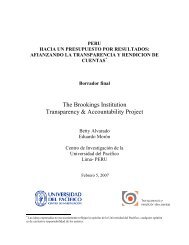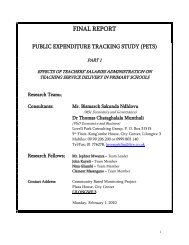Provider Purchasing and Contracting for Health Services_The Case
Provider Purchasing and Contracting for Health Services_The Case
Provider Purchasing and Contracting for Health Services_The Case
Create successful ePaper yourself
Turn your PDF publications into a flip-book with our unique Google optimized e-Paper software.
principles laid down in the National <strong>Health</strong> Polices <strong>and</strong> Strategies of 1992. <strong>The</strong>se emphasized<br />
the right of access to af<strong>for</strong>dable health care of good quality to all Zambians. <strong>The</strong><br />
government’s overall vision was to “provide Zambians with equity of access to costeffective,<br />
quality care as close to the family as possible.” In line with the global trends, the<br />
government adopted the marketization of health care with the identified need <strong>for</strong> greater<br />
efficiency <strong>and</strong> effectiveness of health sector per<strong>for</strong>mance. This was based on strategies<br />
targeting private sector participation directly or indirectly through public-private partnerships<br />
or through per<strong>for</strong>mance-oriented re<strong>for</strong>ms of the public sector (Saltman 1995; Mills 1995).<br />
<strong>The</strong> re<strong>for</strong>ms were driven by declining health care service quality; economic decline <strong>and</strong><br />
scarcity of resources <strong>for</strong> health care <strong>and</strong> other sectors; the desire to restructure the sector <strong>and</strong><br />
make it more responsive to community, households, <strong>and</strong> consumer needs; <strong>and</strong> the desire to<br />
achieve more efficient <strong>and</strong> effective resource use <strong>and</strong> outcomes.<br />
<strong>The</strong> public health re<strong>for</strong>ms spanned the entire public health sector from administration to<br />
service delivery. Administrative re<strong>for</strong>ms included the decentralization of the health system<br />
through the creation of health boards at all levels of the health system. <strong>The</strong> newly created<br />
autonomous District <strong>Health</strong> Boards managed primary health services, while Hospital<br />
Management Boards <strong>and</strong> the Central Board of <strong>Health</strong> managed secondary <strong>and</strong> tertiary<br />
hospital levels <strong>and</strong> the national level, respectively. <strong>The</strong> creation of these autonomous boards<br />
resulted in a broad split between the Ministry of <strong>Health</strong> as a purchaser of services <strong>and</strong> the<br />
autonomous boards as health service providers. This split <strong>for</strong>med the basis <strong>for</strong> the contracting<br />
of health services in the public sector. Mills <strong>and</strong> Broomberg (1998) noted a number of factors<br />
influencing contracting <strong>for</strong> health care, which include the following:<br />
• the changing principles toward public sector management with the growing principles<br />
of per<strong>for</strong>mance-oriented accountability <strong>and</strong> results achievement.<br />
• <strong>Health</strong> outcomes such as life expectancy <strong>and</strong> infant mortality have been declining as<br />
health systems in low-resource settings faced more severe resource constraints <strong>for</strong> a<br />
number of reasons, including poor <strong>and</strong> deteriorating economic conditions, shrinking<br />
public sector resources <strong>and</strong> allocations to health <strong>and</strong> other related public health sectors<br />
(such as water, sanitation, <strong>and</strong> education), as well as emerging or reemerging<br />
conditions such as HIV/AIDs <strong>and</strong> TB.<br />
• <strong>The</strong> desire to maintain equity <strong>and</strong> effectiveness in resource use <strong>and</strong> consumption has<br />
faced difficult challenges.<br />
• Fourthly, the desire to generate accountability, improve quality, <strong>and</strong> increase<br />
consumer satisfaction were also some of the conditions that led to the consideration,<br />
design, <strong>and</strong> implementation of different ways of reimbursing <strong>and</strong> funding health care<br />
services.<br />
Following the decline in the quality of services <strong>and</strong> health outcomes as institutional<br />
per<strong>for</strong>mance became increasingly diminished, the government initiated health re<strong>for</strong>ms in<br />
1992. <strong>The</strong> weak economic per<strong>for</strong>mance affected the private sector probably even more<br />
because the investment <strong>and</strong> regulatory framework <strong>for</strong> private sector participation had not<br />
included appropriate incentives <strong>for</strong> it to respond to consumer needs <strong>and</strong> dem<strong>and</strong>. Yet, the<br />
growth in private sector participation <strong>and</strong> its potential had become evident. One way of<br />
alleviating the declining per<strong>for</strong>mance was to strengthen the public-private partnership.<br />
<strong>The</strong> choice of contracting is underpinned by the notion that public service agents tend to act<br />
inefficiently because they wield bureaucratic control over resources. This adversely affects<br />
the efficiency of health care provision (Walsh 1995; Mills 1998). <strong>The</strong> creation of internal<br />
3
















